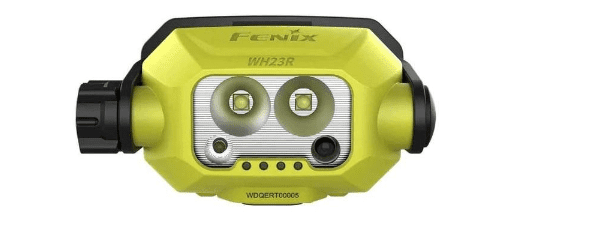Whether you need light during a run, a hike, or DIY work, a headlamp is the best kind of flashlight you might want. Allowing you to illuminate exactly where you need it, keeping your hands free to be used.
Need to pick a new lightweight, compact headlamp, but still powerful enough for the darkness you face? Well, your choice might fall between two models that have recently been released, the Fenix WH23R and the Olight Array 2 pro.
They are both good choices, as they are headlamps with a compact design, lightweight, and rechargeable.
Let’s compare them, first in size:
The Fenix WH23R: measuring 86 mm in length, has a width of 45 mm and 44 mm in height, weighing in at 115 grams; while the Olight Array 2 pro measures 61 mm in length, with a width of 31 mm, and a height of 25 mm, for a total weight of 135 grams. So the Olight is significantly smaller, but a bit heavier than the Fenix.
Both have a built-in lithium-ion battery that is rechargeable via a USB C port, but the Olight has a 3350mAh battery, while the Fenix has a 2000mAh battery. So they are both easy to charge, thanks to the universal USB C port that is adopted by more and more devices; but the Olight has a battery with a significantly larger capacity than the Fenix, one of the aspects that could justify the slight increase in weight. A bigger battery allows not only more peak output but longer runtime.
Beam type: both headlamps feature 2 Emitters. One to generate a flood beam, wide and diffused light useful to illuminate the area around you; great for close distance and proximity illumination. The other Emitter has a spot beam, a concentrated cone of light that will illuminate further than the flood beam, while being narrower; suitable for long-distance illumination. When you need both a flood beam and a throw beam combined, both flashlights can activate the 2 Emitters at the same time, generating a beam that is both wide and reaching longer distances, increasing also the overall output produced by the light. Note that the Olight doesn’t allow only the spot beam to be turned on, it’s only on when combining both beams; while the Fenix can operate singularly the spot or the flood beam. If you often need just a narrower, spot beam, the Fenix is the only choice that can grant you this option.
Also, the Olight has a red LED that provides a soft red beam, with a power of up to 200 lumens. Ideal for signaling or preserving night vision.
And power-wise? The Fenix, combining flood and spot emitters, has a max output of 600 lumens, while the Olight is 1500 lumens. 600 lumens is plenty enough for most situations, but the Olight has more than double the max output.
What about illumination distance? The Fenix has a max throw of 84 meters, while the Olight has a max throw of 150 meters, almost double. If you need more seeing distance, the Olight should be the preferred choice.
Levels and level spacing: both lights have several levels, for both the flood beam, spot beam (only the Fenix), and the combination of the two. The Olight for the flood beam has the following levels: 50 lumens (27.5 hours), 450 lumens (5.5 hours) and 800 lumens (4 hours); combining flood beam and spot beam: 300 lumens (7.5 hours), 750 lumens (4 hours 20 minutes), 1500 lumens (3 hours and 10 minutes); red LED: 45 lumens (18 hours), 100 lumens (6 hours) and 200 lumens (4.5 hours). Fenix has for the flood emitter 5 lumens (150 hours), 70 lumens (15 hours and 36 minutes), 300 lumens (6 hours, 19 minutes); for the spot emitter 30 lumens (25 hours 57 minutes), 120 lumens (9 hours 32 minutes) and 300 lumens (6 hours 19 minutes); combining both beams you have a turbo mode of 600 lumens.
So the Fenix offers less output as stated before, but has a lower output low mode, ideal if you don’t need that much brightness and want to conserve the runtime, while the light has more modes in the flood + spot beam.
Both lights have a traditional switch interface and in addition, a sensor that allows you to operate the light without touching it, just by waving your hand in front of it. So if you are often working with dirty hands, or with gloves, both lights will offer you the practicality of not having to touch the headlamp itself.
Battery indicator? Both lights have s dedicated battery indicator, allowing you to always have the charge of your battery under control.
Regarding the resistance to the environments, the Fenix is rated IP66, while the Olight is IPX4. So the Olight will withstand splashes of water or heavy rain; while the Fenix can withstand pressurized water. If you work with pressurized water, the Fenix will be your best choice.
Finally, pricewise, the Fenix is cheaper than the Olight, while the Olight is still priced at a competitive option for its features (red mode, bigger battery, stronger output). The Fenix is not a slouch either, offering more resistance against water, the ability to run only the spot beam, and a lower low mode.
For overall uses I would recommend the Olight Array 2 Pro: a bigger battery is always better than a smaller battery, and more output is better than less output (and in this case, there’s a very significant difference in brightness between the two).
But if the Olight doesn’t fit in your budget the Fenix is still a good choice in the smart headlamp world.




































